Reflection in a Point
A point reflection exists when a figure is built around a single point called the center of the figure, or point of reflection. For every point in the figure, there is another point found directly opposite it on the other side of the center such that the point of reflection becomes the midpoint of the segment joining the point with its image. Under a point reflection, figures do not change size.
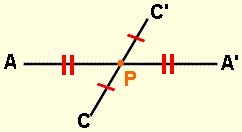 The diagram above shows points A and C reflected through point P. Notice that P is the midpoint of segments \(\overline { A{ A }^{ ‘ } }\) and \(\overline { C{ C }^{ ‘ } }\).
The diagram above shows points A and C reflected through point P. Notice that P is the midpoint of segments \(\overline { A{ A }^{ ‘ } }\) and \(\overline { C{ C }^{ ‘ } }\).
A point reflection creates a figure that is congruent to the original figure and is called an isometry (a transformation that preserves length). Since the orientation in a point reflection remains the same (such as counterclockwise seen in this diagram), a point reflection is more specifically called a direct isometry.
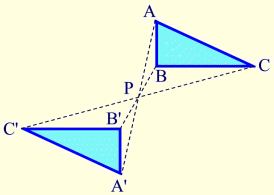
Properties preserved (invariant) under a point reflection:
- distance (lengths of segments are the same)
- angle measures (remain the same)
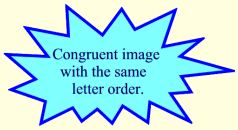
- parallelism (parallel lines remain parallel)
- colinearity (points stay on the same lines)
- midpoint (midpoints remain the same in each figure)
- orientation (lettering order remains the same)
Definition: A reflection in a point P is a transformation of the plane such that the image of the fixed point P is P and for all other points, the image of A is A’ where P is the midpoint of \(\overline { A{ A }^{ ‘ } }\).
A figure that possesses point symmetry can be recognized because it will be the same when rotated 180 degrees. In this same manner, a point reflection can also be called a half-turn (or a rotation of 180º). If the point of reflection is P, the notation may be expressed as a rotation RP,180° or simply RP.
Point Reflection in the Coordinate Plane
While any point in the coordinate plane may be used as a point of reflection, the most commonly used point is the origin. Assume that the origin is the point of reflection unless told otherwise. You may see various notations such as (rotation statements) Rorigin or RO where point O is the origin or (reflection statement) rorigin.
Under a point reflection in the origin the image of (x, y) is (-x, -y).
P(x,y)→P’(-x,-y) or rorigin(x,y) = (-x,-y)
When working with the graph of y = f(x), replace x with -x and y with -y.
f(x) → -f(-x)
Triangle A’B’C’ is the image of triangle ABC after a point reflection in the origin.
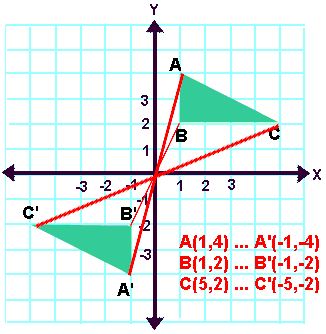 Imagine a straight line connecting A to A’ where the origin is the midpoint of the segment.
Imagine a straight line connecting A to A’ where the origin is the midpoint of the segment.
Notice how the coordinates of triangle A’B’C’ are the same coordinates as triangle ABC, BUT the signs have been changed.
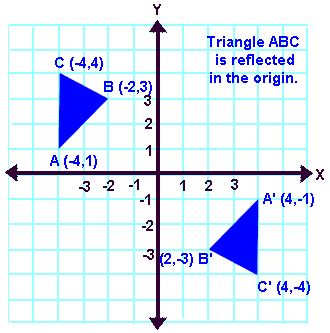 Triangle ABC has been reflected in the origin.
Triangle ABC has been reflected in the origin.